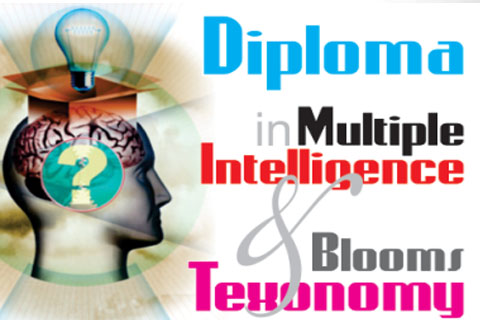Diploma In School Leadership
...

Diploma program on Multiple intelligences in Classroom and Blooms
ABOUT MI
The theory of multiple intelligences was proposed by Howard Gardner in 1983 to more accurately define the concept of intelligence and to address the question whether methods which claim to measure intelligence (or aspects thereof) are truly scientific.
Gardner’s theory argues that intelligence, particularly as it is traditionally defined, does not sufficiently encompass the wide variety of abilities humans display. In his conception, a child who masters multiplication easily is not necessarily more intelligent overall than a child who struggles to do so. The second child may be stronger in another kind of intelligence and therefore 1) may best learn the given material through a different approach, 2) may excel in a field outside of mathematics, or 3) may even be looking at the multiplication process at a fundamentally deeper level, which can result in a seeming slowness that hides a mathematical intelligence that is potentially higher than that of a child who easily memorizes the multiplication table.
The Eight Intelligences :
1) Verbal-Linguistic
– The Writer/Speaker Children with strong Verbal-Linguistic intelligence will have a propensity to produce language and sensitivity to the nuances, order and rhythm of words. These students love to read, write and tell stories. They have good memories for names, places, dates and trivia. Professionals with strong VL intelligence will be writers, public speakers, teachers, and actors. Some historical examples include Abraham Lincoln, T.S. Elliot and Charlton Heston.
2) Math-Logical – The Scientist
Children with strong Math-Logical intelligence have the ability to reason deductively and can recognize and manipulate abstract patterns or relationships. Students who have strong problem-solving and reasoning skills will excel in this intelligence. Adults with this intelligence will work as scientists, mathematicians, computer programmers, lawyers or accountants. Some historical examples include Albert Einstein, Nicolae Tesla, Alexander Graham Bell.
3) Spatial – The Builder
Children with Spatial intelligence have the ability to create visual-spatial representations and can transfer them mentally or concretely. Students who exhibit this intelligence need a mental or physical “picture” to understand the information being presented. Professionals in this intelligence are typically graphic artists, architects, cartographers and sculptors. Some historical examples include Frank Lloyd Wright, Pablo Picasso, and Bobby Fischer.
4) Musical – The Composer
Children with strong Musical intelligence have great sensitivity to the rhythm of sounds (e.g. pitch, timbre, composition). Students strong in this intelligence will enjoy listening to music and may ultimately work as singers, songwriters, composers, or even music teachers. Some historical examples include Ludwig van Beethoven, J.S. Bach, and Mozart.
5) Bodily-Kinesthetic – The Athlete
Children with strong Bodily-Kinesthetic intelligence gravitate towards athletics; however, they also may use their bodies to solve problems, or convey ideas and emotions. Students with BK intelligence will be good at physical activities, have good hand-eye coordination and may have a tendency to move around a lot while expressing themselves. Professionals using BK intelligence will include athletes, surgeons, dancers and even inventors. Some historical examples include Michael Jordan, Tiger Woods, and Andre Agassi.
6) Interpersonal – The Peacemaker
Children with strong Interpersonal intelligence work effectively in a group and understand and recognize the goals, motivations and intentions of others. Students with this intelligence thrive in cooperative, group work situations and are skilled at communicating, mediating and negotiating. Professionals in this intelligence may be teachers, therapists, and salespeople. Some historical examples include Mohandas Gandhi, Mother Theresa and Ronald Reagan.
7) Intrapersonal – The Philosopher
Children who are strong in the Intrapersonal intelligence have the ability to understand one’s own emotions, goals and motivations. These students have good instincts about their strengths and abilities. This intelligence will be highly developed in professionals who work as philosophers, psychiatrists or religious leaders. Some historical examples include Eleanor Roosevelt and Sigmund Freud.
8.) Naturalist – The Earth Lover
Children with strong focus in this intelligence will exhibit an affinity for all things nature. These students will enjoy and thrive when learning about nature topics, such as flora and fauna. Some professions with focus on this intelligence will include forest rangers, botanists, farmers and biologists. Some historical examples include Charles Darwin, John Muir.
ABOUT BT
In 1956, Benjamin Bloom headed a group of educational psychologists who developed a classification of levels of intellectual behavior important in learning. Bloom found that over 95 % of the test questions students encounter require them to think only at the lowest possible level…the recall of information.Bloom identified six levels within the cognitive domain, from the simple recall or recognition of facts, as the lowest level, through increasingly more complex and abstract mental levels, to the highest order which is classified as evaluation.
Six levels of Blooms :
| S.No. | Course title |
|---|---|
| 1 | MULTIPLE INTELLIGENCES AND BLOOM’S TAXONOMY (RESOURCE GUIDE) |
| 2 | MULTIPLE INTELLIGENCES BASED ASSESSMENT |
| 3 | TECHNOLOGY INTEGRATION WITH MULTIPLE INTELLIGENCES AND BLOOM’S TAXONOMY |
| 4 | INTEGRATION OF MULTIPLE INTELLIGENCES AND BLOOM’S TAXONOMY |
| 5 | BLOOM’S TAXONOMY IN CLASSROOM |
| 6 | MULTIPLE INTELLIGENCES |